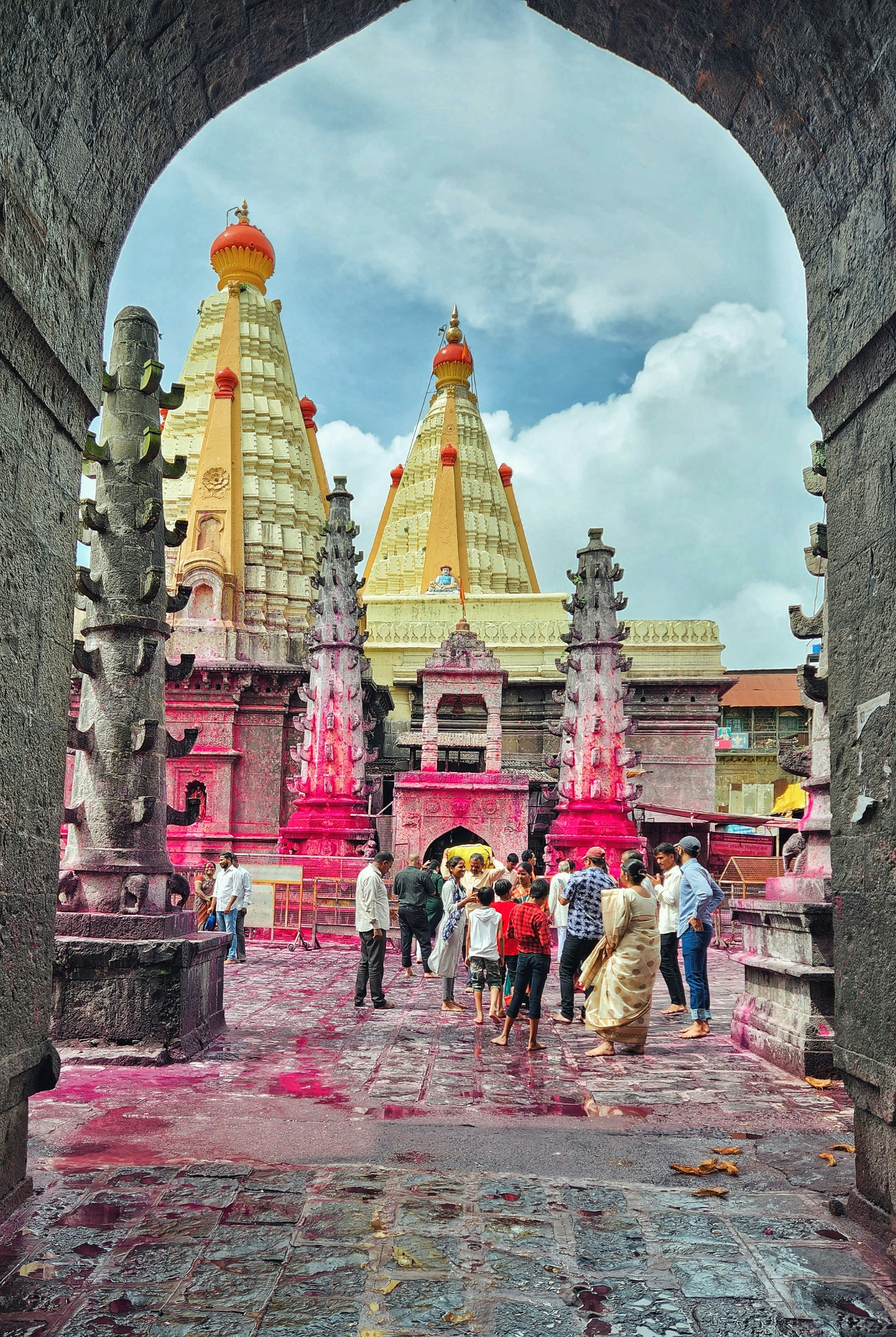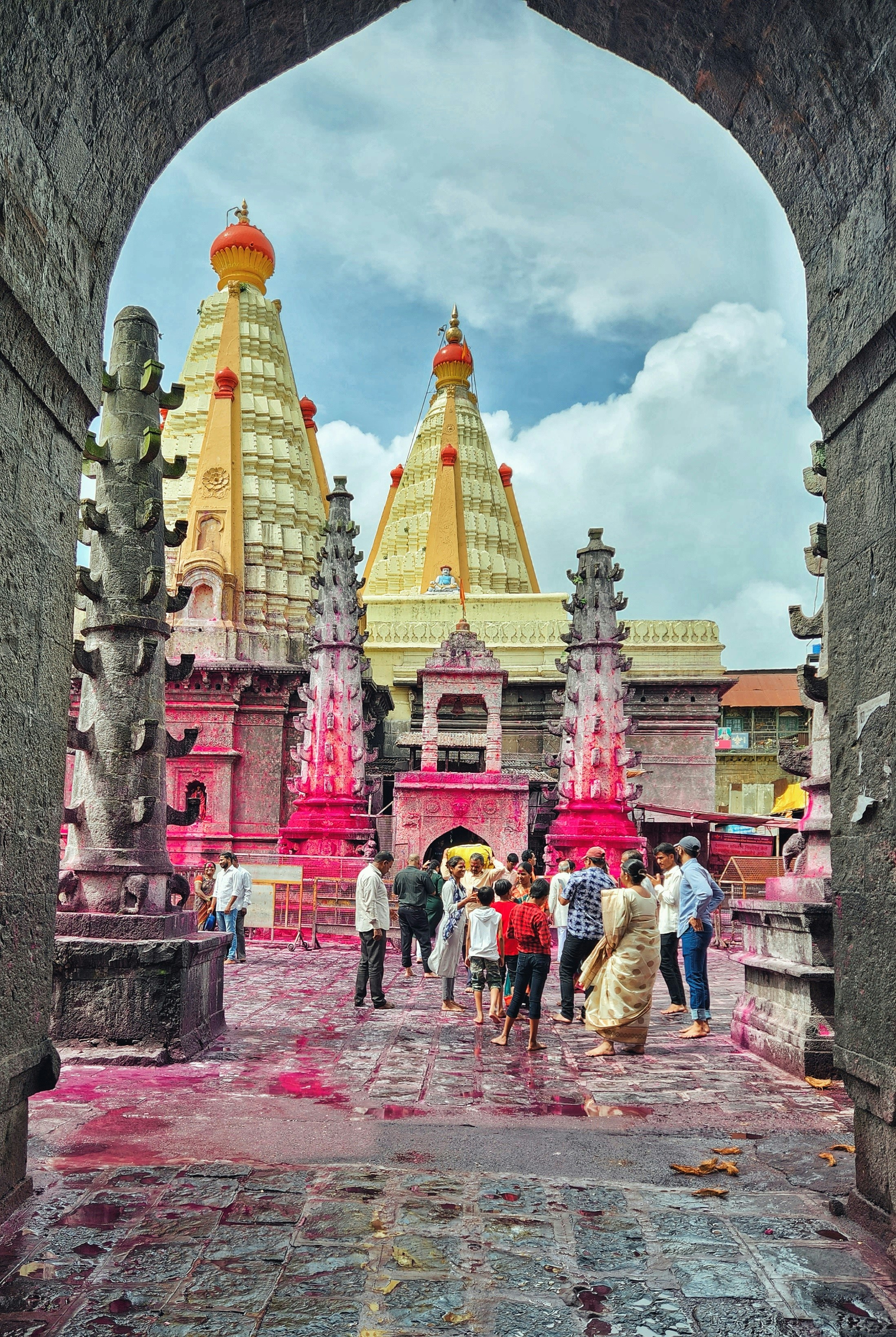As you make your way up the winding path that leads to the Jyotiba Temple, you can feel a sense of tranquility enveloping you. The air is filled with the fragrance of incense and the soft sound of bells chiming in the distance. The temple itself is a sight to behold, with its intricate architecture and vibrant colors. Dedicated to the Hindu deity Jyotiba, the temple is believed to have been built in the 17th century and has since become a symbol of devotion and faith.
Once inside the temple, you are greeted by the soothing chants of the priests and the warm glow of oil lamps. The atmosphere is alive with devotion, as devotees offer prayers and seek blessings from the deity. The main sanctum of the temple houses the idol of Jyotiba, adorned with flowers and garlands. It is said that the deity grants the wishes of those who visit with a pure heart and a sincere desire.
But the Jyotiba Temple is not just a place of worship; it is also a haven for nature lovers and adventure enthusiasts. Perched atop the Jyotiba Hill, the temple offers breathtaking panoramic views of the surrounding landscape. From here, you can see the lush green valleys, the winding rivers, and the distant peaks of the Western Ghats. It is a sight that will leave you in awe of the beauty of nature.
For those seeking adventure, the Jyotiba Hill is also a popular spot for trekking and hiking. The rugged terrain and dense forests provide the perfect backdrop for an exhilarating outdoor experience. As you explore the trails, you will come across hidden waterfalls, ancient caves, and a variety of flora and fauna. It is a journey that will not only challenge you physically but also rejuvenate your mind and soul.
After a day of exploration and adventure, you can indulge in the delicious local cuisine at the nearby eateries. From traditional Maharashtrian thalis to lip-smacking street food, there is something to satisfy every palate. Don’t forget to try the famous Kolhapuri cuisine, known for its spicy flavors and rich gravies.
Whether you are a devotee seeking spiritual solace or an adventure enthusiast looking for a thrilling experience, the Jyotiba Temple is a destination that will captivate your senses and leave you with memories to cherish for a lifetime. So, pack your bags and embark on a journey to this majestic hilltop sanctuary in Maharashtra.
A Brief History
The Jyotiba Temple, also known as Kedarnath Temple, has a rich history that dates back to the 17th century. It is dedicated to the Hindu deity Jyotiba, who is believed to be an incarnation of Lord Khandoba. The temple was built by the ruler of Kolhapur, Raja Maloji Bhosale, as a symbol of his devotion and gratitude towards Jyotiba.
Legend has it that Jyotiba appeared in the dreams of Raja Maloji Bhosale and instructed him to build a temple on the hilltop. The ruler followed the divine command and constructed the temple, which has since become a revered pilgrimage site for devotees from all over the country.
Over the centuries, the Jyotiba Temple has witnessed various historical events and undergone several renovations and expansions. It has stood as a testament to the enduring faith and devotion of countless devotees who have flocked to its sacred grounds seeking solace and blessings.
During the reign of the Maratha Empire, the temple gained even more prominence as it became a favored destination for the Maratha rulers and their subjects. The temple’s grandeur and spiritual significance attracted devotees from far and wide, solidifying its reputation as a significant religious site.
Throughout its history, the Jyotiba Temple has faced numerous challenges, including natural disasters and invasions, but it has always managed to rise above them and retain its sanctity. The temple’s architecture reflects a blend of different styles, showcasing the influence of various dynasties and rulers who have contributed to its construction and preservation.
Today, the Jyotiba Temple stands as a magnificent edifice, perched on a hilltop amidst lush greenery. It offers breathtaking views of the surrounding landscape, adding to the spiritual experience of the devotees who make the arduous journey to seek the blessings of Jyotiba.
The temple complex comprises several other smaller shrines dedicated to different deities, creating a serene and peaceful atmosphere for worship and contemplation. The annual festival of Jyotiba, known as Jyotiba Yatra, draws thousands of devotees who participate in various rituals and celebrations to honor the deity.
Visiting the Jyotiba Temple is not just a religious pilgrimage but also an opportunity to immerse oneself in the rich history and cultural heritage of the region. The temple’s significance extends beyond its religious importance, serving as a reminder of the deep-rooted spirituality and devotion that has shaped the lives of countless individuals throughout the centuries.
The Spiritual Significance
Jyotiba Temple holds immense spiritual significance for Hindus, who believe that worshipping Jyotiba can fulfill their wishes and bring them prosperity and happiness. The temple is particularly popular among couples seeking blessings for a happy married life and childless couples praying for the gift of parenthood.
Devotees flock to the temple throughout the year, but the atmosphere becomes truly electrifying during the festival of Navratri. The nine-day festival is celebrated with great fervor and devotion, with devotees offering prayers, performing rituals, and participating in colorful processions.
The temple complex also houses several other shrines dedicated to various deities, including Goddess Mahalaxmi, Lord Ganesh, and Lord Hanuman. Each shrine exudes a unique aura of divinity and adds to the overall spiritual experience of the devotees.
As devotees enter the temple complex, they are greeted by the mesmerizing sound of bells, the fragrance of incense, and the sight of vibrant flowers adorning the statues of the deities. The air is filled with a palpable sense of devotion and reverence, as devotees bow their heads and offer their prayers.
Inside the main temple, the idol of Jyotiba is placed on a beautifully adorned pedestal, radiating an aura of divine energy. Devotees queue up patiently, waiting for their turn to offer their prayers and seek the blessings of Jyotiba.
Many devotees bring offerings such as coconuts, flowers, and sweets as a token of their devotion. They believe that by offering these items, they are expressing their gratitude and seeking the blessings of the deity.
Outside the main temple, devotees can be seen engaging in various religious activities. Some sit in quiet meditation, seeking inner peace and spiritual enlightenment, while others participate in the chanting of hymns and mantras.
Throughout the day, priests perform elaborate rituals, invoking the presence of the deities and seeking their blessings for the devotees. The sound of the conch shell and the rhythmic beating of drums create a mystical ambiance, transporting the devotees into a realm of spiritual bliss.
As the sun sets, the temple complex is illuminated with thousands of twinkling lights, creating a magical atmosphere. Devotees gather for the evening aarti, a ritualistic worship ceremony where the deities are worshipped with fire, incense, and sacred chants.
The aarti is a mesmerizing spectacle, with the priests waving the lamps in graceful patterns, accompanied by the melodious singing of devotional songs. The devotees join in the singing, their voices blending together in harmonious devotion.
As the aarti concludes, the devotees bow their heads in gratitude, their hearts filled with a deep sense of spiritual fulfillment. They leave the temple complex, carrying with them the blessings and positive energy they have received from Jyotiba and the other deities.
For the devotees, visiting Jyotiba Temple is not just a religious obligation, but a transformative experience that nourishes their souls and strengthens their connection with the divine. It is a place where they can find solace, seek guidance, and experience the profound power of faith.
As you ascend the Jyotiba Hill, you will be greeted by a symphony of sounds from the chirping of birds to the rustling of leaves in the gentle breeze. The mesmerizing surroundings are home to a diverse range of flora and fauna, making it a paradise for nature enthusiasts.
The lush greenery that blankets the hills is a sight to behold. The vibrant hues of the trees and plants create a kaleidoscope of colors that is truly awe-inspiring. As you walk along the trekking trails, you will come across a variety of plant species, some of which are unique to this region.
The fragrance of wildflowers fills the air, adding a touch of sweetness to the already enchanting atmosphere. You may even spot some rare and exotic flowers that bloom only in this pristine environment. Photographers will find themselves captivated by the vibrant colors and intricate details of these floral wonders.
The fauna of the region is equally captivating. You may encounter a variety of bird species, from colorful parrots to majestic eagles soaring high above the hills. Keep your eyes peeled for squirrels scurrying through the trees and monkeys swinging from branch to branch.
As you reach the summit, the panoramic views of the surrounding landscape will leave you spellbound. The rolling hills seem to stretch on forever, their peaks disappearing into the horizon. The tranquility of the scene is enhanced by the absence of any human-made structures, allowing you to immerse yourself fully in the beauty of nature.
Whether you choose to meditate in the temple complex, embark on a trekking adventure, or simply take a leisurely stroll, the mesmerizing surroundings of the Jyotiba Hill will leave an indelible mark on your soul. It is a place where you can escape the chaos of everyday life and find solace in the embrace of nature.
Getting There
Jyotiba Temple is located near the city of Kolhapur in Maharashtra. The temple, situated atop a hill, offers breathtaking views of the surrounding landscape and is a popular pilgrimage site for devotees of Lord Jyotiba.
For those planning to visit the temple, there are several convenient modes of transportation available. If you are coming from other parts of India, the nearest airport is Kolhapur Airport, which is well-connected to major cities in the country. Flights from cities like Mumbai, Delhi, and Bangalore operate regularly, making it easy for travelers to reach Kolhapur. From the airport, one can hire a taxi or take a bus to reach the temple.
If you prefer traveling by train, the nearest railway station is Kolhapur Railway Station. This station is well-connected to cities like Mumbai, Pune, and Bangalore, with regular trains plying on these routes. Travelers can choose from a range of options, including express trains and superfast trains, depending on their preference and budget. From the railway station, one can hire a cab or take a local bus to reach the temple.
For those who enjoy road trips, the temple is easily accessible via the well-maintained road network. State-run buses and private taxis are available from major cities in Maharashtra, such as Mumbai, Pune, and Nashik, to reach the temple. The journey by road offers scenic views of the countryside, with lush green fields and small villages dotting the landscape.
Once you reach the vicinity of the temple, you can choose to either hike up the hill or take a cable car to reach the temple premises. The cable car ride is a popular choice among visitors, as it offers a thrilling experience and panoramic views of the surrounding area.
Overall, reaching Jyotiba Temple is a hassle-free experience, thanks to the well-connected transportation options available. Whether you prefer air travel, train journeys, or road trips, you can easily plan your visit to this sacred site and immerse yourself in the spiritual ambiance of the temple.
Enter your email to get the Latest Updated Exploring News and Topics
Discover more from atozexplore.com
Subscribe to get the latest posts sent to your email.







